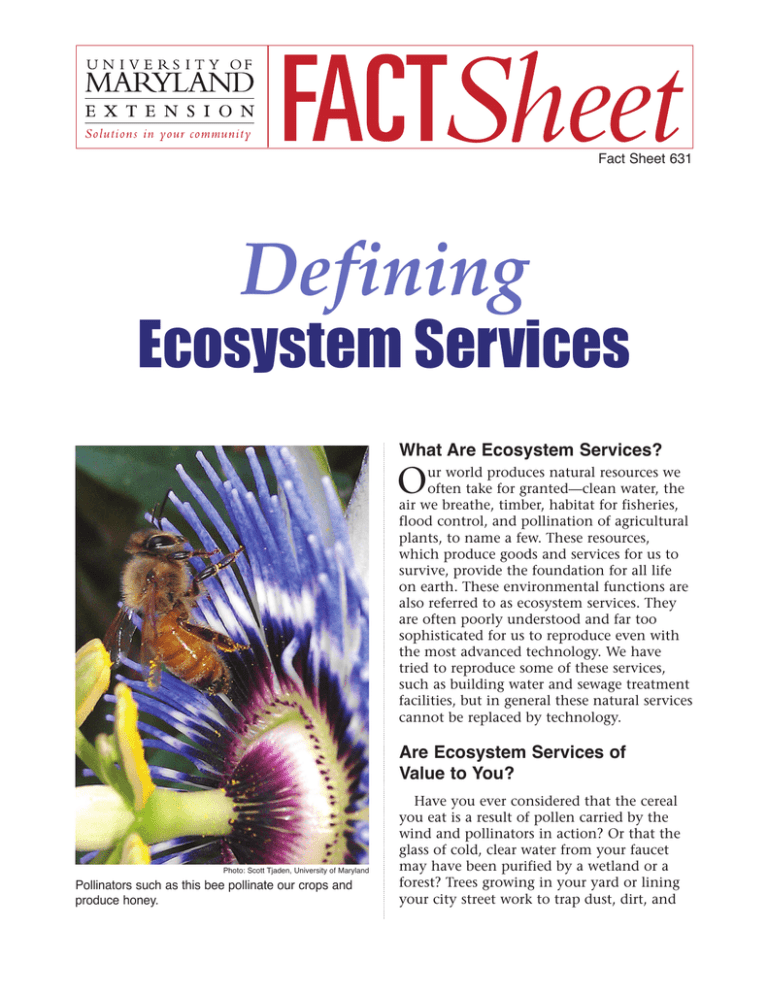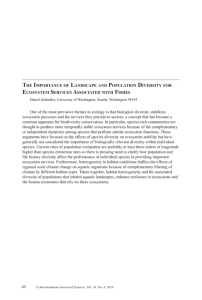Defining Ecosystem Services O
advertisement

Fact Sheet 631 Defining Ecosystem Services What Are Ecosystem Services? O ur world produces natural resources we often take for granted—clean water, the air we breathe, timber, habitat for fisheries, flood control, and pollination of agricultural plants, to name a few. These resources, which produce goods and services for us to survive, provide the foundation for all life on earth. These environmental functions are also referred to as ecosystem services. They are often poorly understood and far too sophisticated for us to reproduce even with the most advanced technology. We have tried to reproduce some of these services, such as building water and sewage treatment facilities, but in general these natural services cannot be replaced by technology. Are Ecosystem Services of Value to You? Photo: Scott Tjaden, University of Maryland Pollinators such as this bee pollinate our crops and produce honey. Have you ever considered that the cereal you eat is a result of pollen carried by the wind and pollinators in action? Or that the glass of cold, clear water from your faucet may have been purified by a wetland or a forest? Trees growing in your yard or lining your city street work to trap dust, dirt, and Wetlands provide fish and wildlife habitat, mitigate and control flood damage, and help filter pollutants and runoff. Photo: Brian Needelman, University of Maryland harmful gases from the air you breathe. Flood plains next to a stream or river provide important flood control functions during peak rainfall events as well as supply critical wildlife and fisheries habitat. Trees such as the birch or ginkgo biloba, which have many medicinal values, are used for memory loss, blood circulation, and musculoskeletal disorders. These natural ecosystems perform fundamental life-support services and provide many goods for mankind. Yet to date, the important roles of these natural services have not been recognized adequately in economic markets, government policies, or land management practices. Ecosystem Services Examples • enrich recreation • moderate weather extremes and their impacts • mitigate drought and floods • generate and preserve soils and renew their fertility • provide wildlife habitat • purify air and water • supply wood fiber (lumber and paper) • pollinate crops and natural vegetation • protect stream and river channels and coastal shores from erosion • create aesthetic beauty • decompose wastes • supply waterways (transportation of goods and services) • make hunting available • enhance property values • yield fisheries • generate hydroelectric power • control agricultural pests • stimulate our mind and lift the human spirit • maintain biodiversity 2 Much of our land enhances biodiversity. It also provides valuable wildlife habitat that supports recreational activities such as hunting, fishing and bird-watching. Photo courtesy of USDA Natural Resources Conservation Service What Are Ecosystem Services Worth? water. Major cities, such as New York, have invested in tree planting projects and in enhancing existing forests in New York State’s Catskill Mountains. Portland, Maine, is investing in tree planting projects and protecting existing forests in the surrounding watersheds, specifically with the purpose of improving water quality and moderating water temperatures. Natural ecosystems and their plants and animals provide us with services that would be hard, even impossible, to duplicate. While it’s tough to accurately price an ecosystem service, we can estimate some of the financial values. For example: • Much of the Mississippi River Valley’s natural flood protection services were destroyed when adjacent wetlands were drained and channels altered over many years. As a result, the 1973, 1993, and 2011 floods resulted in property damages estimated in the billions of dollars, partially because the valley had been stripped of its ability to reduce the impacts of high volumes of water. Human civilization depends on the continuation of ecosystem services. Our efforts to recognize, maintain, and enhance ecosystem services will benefit mankind today and in the future. A healthy ecosystem serves not only mankind but all living things. • Over 100,000 different animal species pollinate for free—including bats, bees, flies, moths, beetles, birds, and butterflies. One-third of the planet’s food comes from plants pollinated by wild pollinators. The value of pollination services from wild pollinators in this country alone is estimated at four to six billion dollars per year. • Maintaining existing forests and planting new trees help maintain water quality and also regulate water temperatures. These forests help municipalities save billions of dollars by minimizing major capital improvement projects to purify and cool our drinking Photo: Mary Ann Fajvan, West Virginia University, Bugwood.org Forests help purify the air, filter and purify drinking water, enhance groundwater replenishment, and supply timber products. 3 Defining Ecosystem Services Written by Bob Tjaden Extension Specialist University of Maryland, College Park, Department of Environmental Science & Technology Nancy Stewart Faculty Extension Assistant University of Maryland Extension Brian A. Needelman Associate Professor Department of Environmental Science & Technology Issued in furtherance of Cooperative Extension work, acts of May 8 and June 30, 1914, in cooperation with the U.S. Department of Agriculture, University of Maryland, College Park, and local governments. Cheng-i Wei, Director of University of Maryland Extension. The University of Maryland is equal opportunity. The University’s policies, programs, and activities are in conformance with pertinent Federal and State laws and regulations on nondiscrimination regarding race, color, religion, age, national origin, gender, sexual orientation, marital or parental status, or disability. Inquiries regarding compliance with Title VI of the Civil Rights Act of 1964, as amended; Title IX of the Educational Amendments; Section 504 of the Rehabilitation Act of 1973; and the Americans With Disabilities Act of 1990; or related legal requirements should be directed to the Director of Human Resources Management, Office of the Dean, College of Agriculture and Natural Resources, Symons Hall, College Park, MD 20742. P2012 4






